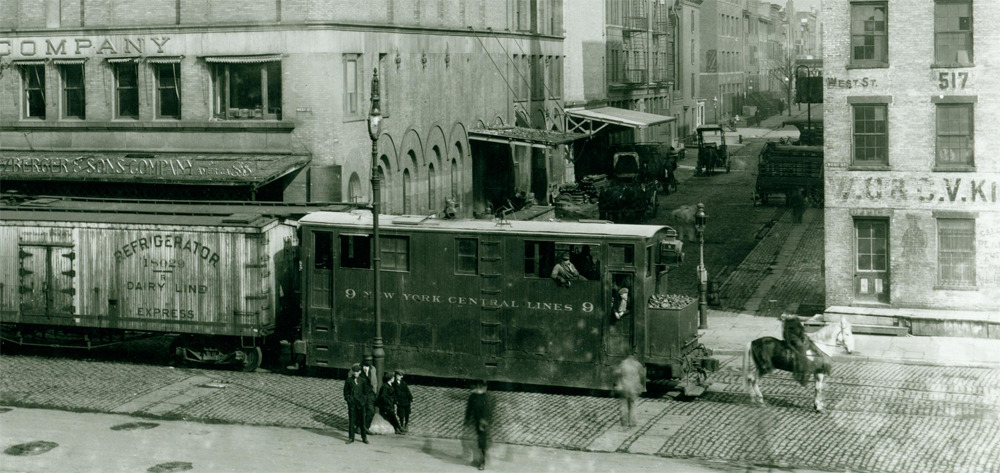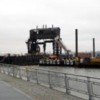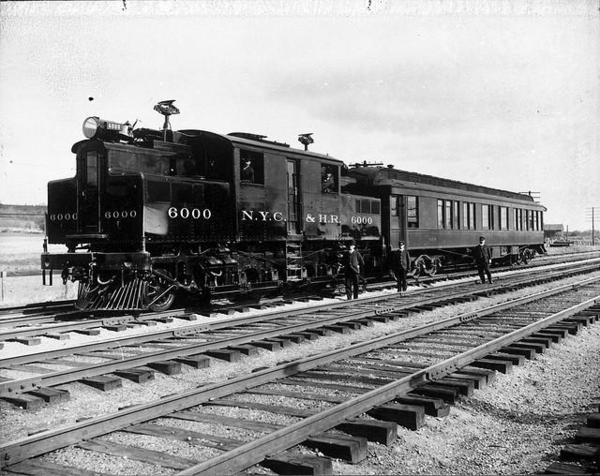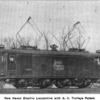
Replies sorted oldest to newest
Before the New York Central High Line on the west side of Manhattan from 34th St. south to Little John St. serving the general post office and the meat markets and other industries. The locomotive is a Shay shrouded as not to scare horses that were used to pull wagons until motor trucks were fully used in the early 1920's. The person on the horseback acted as a flagman when crossing at intersections and were known as west side cowboys. The high line opened in the early 1930.s.
Great historic photograph. Thanks CCrider.
That's Classic! Modern tri-power with a horse escort!
Bob
The photo you posted is interesting as some of the cars in the photo are from 1939-40. Still street running in Manhattan this late. I believe the Horsemen were referred to as the "10th ave cowboys."
Definitely would not have guessed horses on the streets of NY that late, and, to the right in Bob's photo I see the rear of a "Fleetline" GM car, 1942 for sure, and maybe 1947-48.
You can see a 1939 Pontiac (with its trunk striping) just to the right of the loco. Uh..
were those REALLY Shays, even in that earliest photo above? Those later are boxcab
diesels? No visibility safety striping across the fronts of the locos as common to gas
electrics of the period......wonder if they operated at night, with the horseman? And
wonder what the horses thought with that just behind them?....took some training.
That last picture is the St Johnsbury building on West and W. Houston St. Was a large freight transfer warehouse as can be evidenced by the number of tracks and the number of truck loading docks I was in that building many times as Merrill Lynch took it over in the 1970's and had one of their largest data centers in it What was once all trains became all mainframe computers
The pictures of the 10th ave cowboy are north of where the high line terminated hence still street running You can see the high line behind the horse in one of the pictures
GREAT photos! ![]()
Though it was barely used, I once saw a freight car being moved up on the high line back in the mid 70's or so. According to legend, the last delivery happened around 1980, supposedly a load of frozen turkeys. At one point they had proposed putting light rail on the high line, to add to the transportation system on the far west side of Manhattan, but it obviously never happened. Ironically, one of the reasons they proposed the light rail was to help spur development on the west side, replacing mostly moribund warehouses and such with new businesses, and the high line park that now is finished up into the 30's, has done just that, the land along the high line is now some of the most expensive in NYC, all these high end shops, restaurants, apartment buildings and the like (me, I kind of liked the old days, could do without the beautiful people and all the young twits drinking themselves into oblivion, but that's me). In any event, when the weather is nice, if you get to NYC, go for a stroll...they have sort of recreated the train tracks on the high line, so you at least get a glimmer of what it was like. The High line was a classic example of something obsolete by the time it was built, it was finished just as trucks took over a lot of the shipping for the meat packing district and the west chelsea warehouses and such.
Addig to the evolution of the S class locomotive story we have: These engines trace its heritage to what we know in prototype as the New York Central S-1, S-2 class electrics developed for the conversion to Electric Propulsion to Grand Central Terminal. The Original locomotive numbered 6000 was delivered in 1904 for testing. The design was refined including the addition of the pilot trucks and duplicates , the S-2 class were ordered in 1906. Actual Electric Service began in 1907 and at that time the locomotives were numbered in the 3400 series. In 1908, a final order was delivered with what was the S-3 class. These were numbered in 3200 series and the earlier locomotives were all renumbered into the 3200 series as well. The Prototype no. 6000 became No. 3200 . This was the number that IVES assigned to their O Gauge version of the engine.
These locomotives were used on the New York Central Electrified lines right into the Penn Central Era. The Original class engine No 6000 which became No 3200 in 1908 , was again renumbered in 1936 to No. 100. Many will recall Lionel's recent scale model of No. 100. Suffice it to say that back in 1910, these machines were capturing the imagination of toy train hobbyists and or boys and therefore the Ives No 3200 in 1910. Lionel also offerred models of these engines in that time both Standard and O gauge.
Great photo of the 3401 . The changes you can pick up are interesting including the pantograph design, the headlights and the change in the letterring. Notice this one says New York Central Lines but still has the NYC&HR under the number.
these motors returned when the central made the decision to modify them for service into Grand Central in 1955. When they were completed , the factory painted these in the two tone gray lightning stripes which i believe was a first for an electric locomotive on the New York Central. T motors were also done in the mid 50's. Some of these in this scheme lasted into the Penn Central Era. Thanks for posting the photo Bob.
I find it hard to believe that so much of the NYC rails were elevated. When I went there, I saw elevated roads and also wondered if they're on any of the old railroad stuff? I guess when space is tight, it justifies the extra work and expense.
You guys are probably used to seeing it. If you're from different places, maybe you'd wonder why too?? Looking just at the pics, it seems like all the RRs had a tough go of it there, with the space and the water. So much in such a small area going on. People probably wondered why I was staring at the elevated pieces so much.
I'm still amazed. It really is the "big" apple. They weren't messing around, were they?
I guess each area of the country has demands. Mountains, rivers, etc., all get conquered by the RRs.
Too bad they let go of the Buffalo Term here. It's built on such a huge scale. Would have been great to refurb it like the Grand C was. Just rambling again.
Keep in mind the high line was kind of a unique thing, even in NYC. The reason it was built was because of the danger of rail traffic at street level along 10th avenue)...from what I know of the rail yards and the tracks in/out of NYC, most of them were ground level, the west side tracks that Amtrak uses these days, for example, are in deep cut or ground level most of the way, with some sections raised off the ground, specifically around 125th street. One of the big yards are located where there is the Trump Development up in the 70's, that is built over the old NYC rail yards. The old Penn Yard still exists, it is used by LIRR and NJtransit and amtrak these days, and soon will be covered over for a future development (still used, though).
The west side of Manhattan also had all these railroad ferry slips, where I assume they 'floated' freight cars into Manhattan, by the time I remember them, in the 1970's, they were long abandoned, many of them later had fires and such, most of them now, fortunately, have been torn down, they were eyesores. I don't know if the Pennsylvania every used its tunnels under the Hudson for freight (I assume so, but I don't know), so the other railroads I would assume had to use car ferries, or they would bring them in from the north.
The big rail yards in the city were in places like the South Bronx and out in Queens, where the space was available, the ones in Manhattan from the pictures I have seen were relatively small (thought tucked into Manhattan, pretty impressive).
The New York Central also ran down the Hudson on the other side of the river. It terminated in Weehawken NJ Weehawken was miles and miles of Railroad yards. The New York Central had a large ferry terminal there
Attachments
Thanks for the photos of Weehawken. Although much of the modern day passenger trqins operating out of Weehawken were commuter runs, The New York Central did operate to Albany from here and New York Ontario and Western had trackage rights over the New York Central to Weehawken for its trains. The NYO&W operated many trains to the Catskills from Weehawken in the summer. The New York central ferries reached Weehawken from two Manhattan locations: W 42nd street which was a quick crossing but had the added attraction of offerring a great view of the transatlantic liners when they docked in New York and a longer trip from Cortland street , about 25 minutes in Downtown manhattan. IT was one of the nicest rides on the Hudson River Ferries and you could get a great view of the port facilities in New Jersey and on the other side, the New York Piers as you worked your way up the Hudson River.
Nice photo of the NYC Niagara. It looks like she is heading downtown to the Cortlandt st slip. There is also a boat at the 42nd street slip probably getting ready to depart for weehawken. Also across the river is an American Export Liner moored at the pier . The Hudson River Day Line boat is tied up as well.
Judging by the light and the makeup of the NYC train in the photo, I would guess that we see the Twentieth Century Limited making its final leg into Grand Central from Chicago.
Interesting about the steam heat trailers. No one yet has made one of these in O gauge . These type of cars were used by other railroads as well. I read recently that the Union Pacific had these typse of cars and needed them because of train length, ie the train was of a length that the steam boilers in the diesels gouldnt generate sufficient steam for such a lenghthy train.
This is a fantastic thread guys!! Thanks so much for posting these photos. I am a New York City fan and of course New York Central fan as well....love the history lesson here!
Alan
On the West side freight line, the Central had a large yard and marine facilities at 60th street. Today its a park and there is an Alco Switcher on display and a float bridge being restored. Take a gander at some photos of the yard in 1960 and now.
Attachments
As a kid growing up I lived close to the New York Central Harlem Division 3rd rail Electric Line. I would sit on our porch or along the tracks and watch trains, MU cars, T1 Electrics, and later on P motors go by. At about rush hour long express commuter trains with many cars would rush by. It was a way to pass the afternoon by counting the cars.
Once in a while when returning home from school a work train handled by a steamer would be working the line. Boy was that exciting to see. In the winter I did notice some express trains with a steam heater car behind a freight locomotive (Motor) with a trail of steam exhaust coming out of a stack. Did not know what that was for till many years later.
I also would see double headed S motors pulling express trains. Later on I would see them at Grand Central Terminal working as switchers shunting cars around. So when Lionel came out with their model of the S1, I put my money down and quickly bought one..
I used to work with a gentleman who had been an engineer for the New York Central and used to run S1 motors. He had a story about the motor getting hung up (stuck in neutral). The fix was to go to the front or back where the electrical stuff was and whack a relay or something like that with a 2x4 and it would start up. I guess it was a temporary fix for a 60+ year old electric.
Here is an article on 10th Avenue trains and the "The Original Urban Cowboy" - with video.
Great info and pics but video does not play?
This is right under the West Side Highway . There were some interesting trains that came down this line. Milk cars were brought from the Rutland interchange at Chatham NY . This was milk from the Vermont Milkshed. There were processing plants uptown around 110th street and one further downtown. Also general freight some of which was floated to various locations around the NYC waterfront. There were the meat reefers as well for all the packing houses on the West Side. New York Central ran M&E trains down these lines as well. In an earlier post , someone had noted no passenger trains on the high line but M&E and Milk Trains were operated on passenger schedules.
In the photo, the billboard with the airliner is very interesting. Also that passenger car next to the locomotives looks like its used for an office. I wonder what the sign placard on the end of the car was used for.
 Here is an interesting one Park Ave with he tracks still visible
Here is an interesting one Park Ave with he tracks still visible
Great picture! Question, was the train there all along and what became park avenue built on top of it? I would assume so, given that when the rails were put in, Manhattan above 42nd street was sparsely populated.
When the Grand Central Terminal projetc was undertaken around the turn of the century, the tracks leading to the existing station were lowered in the vicinity of the staion, probably from about 96th street south. North of there they were elevated.
When the terminal was built, tracks were lowered in the area one by one, moving from East to the west. The two photos show the tracks as they existed after lowering but before the railroad was completely decked over. In the last photo, you can see the steel framework starting on the right side of the street. The earlier photo is probably about 10 years later but before the median was completely covered over.
Those are awesome pics Ben & Bob. While not appropriate for my era (late 60s thru early 80s) I think I will incoprporate that open median look into my future layout. Very cool. ![]()
This photo is quite interesting in that it shows the actual construction plan that was followed to build the new terminal while the railroads maintained service as well. You can see tthat they were excavating and lowering a track at a time starting on the east side of the station and moving west as they progressed.
The electrification was in service by September 1906 for the New York Central and the following april and May for the New Haven Railroad.
The entire terminal project was completed in 1913 following about a 10 year program of planning design and construction without interrupting service in and out of the terminal. GCT is celebrating its 100th Birthday this year. There will be a Parade of Trains celebration this coming weekend May 11-12th. About 40 pieces of equipment including Metro North Equipment and private railcars will be open to the public.Also a train show and display in Vanderbilt hall. I am planning to go on Sunday
Here is a photo of the first passenger New haven Electrics EP-1. This class was known on the railroad as the Pioneers.
Here is a photo of the Prototype S-1 electric of the New York Central before they went into service.
Another photo of the GCT construction. You can make out the old terminal and the trainshed on the right in the photo
Attachments
Bob
It was probably the New York Central's first revenue electric train leaving the newly electrified Grand Central Terminal. This train is in the Western portion of the station and is on grade. On the East Side of the terminal, work was already underway to depress the tracks below grade. Service to Grand Central Terminal was electrified about 6 1/2 years before the present day Terminal was opened for traffic.
Bob
Staufers Later Power mentions the first electric revenue run as February 13,1907. So the Photo in the Scientific American predates this so it was a trial run as they say. The cars in the photo are locomotive hauled cars. Per Staufer ,The train on that day was a run up to Wakefield on the Harlem line where there was an engine change/terminal facility. Similar service to Highbridge came later with complete electric service between HighBridge and Grand Central and Wakefield and Grand Central by July 1 1907. MU trains were steam powered north of these points as the cars had provisions for Steam heating as well as electric. The S motors handled the standard rail car trains South of Highbridge and Wakefield.
Those look like pretty big steamers in the Highbridge photo, probably early pacifics.
Here's an aerial view of the Hudson Division in the Bronx showing 2 famous New York City landmarks:
Peter
Attachments
I have been looking at this picture wondering why both pantographs are up. Was this before they figured out to just leave the back one up? Or was this just a phot op

I'd love to find an online reference showing the paint and lettering scheme of the cars in the trains the first S-1s pulled. Am working on a tinplate version of that train and need pics for lettering reference.
Thanks,
Bert
I'd love to find an online reference showing the paint and lettering scheme of the cars in the trains the first S-1s pulled. Am working on a tinplate version of that train and need pics for lettering reference.
Thanks,
Bert
Hi, Bert.
I you have access to a copy of the Staufer book titled "New York Central's Early Power: 1831-1916", there are plenty of photographs which show the types of passenger equipment in service during the early stages of S-motor operation (lots of arched windows). I'll look through some of my other material to see what I can find but that book would be a good starting point.
Bob



































